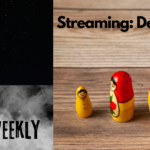With obscure names like Always Funny Videos, America’s Test Kitchen, Billiard TV, and Game Show Central, niche programs proliferate on streaming TV where hundreds of channels compete for viewers and advertisers.
You’ve probably noticed that many channels on major streaming networks like Samsung TV will interrupt programming and cut to breaks with no commercials in sight.
Commercial Breaks Void of Ads
Instead, they run static slide shows promoting their content lineup or photos to fill the time. From the viewer’s perspective, these breaks can be more annoying than bad commercials. The frequent repetition and intrusion into their experience can be extremely tedious.
Streaming channels may still run breaks even if they run promos instead of advertising because they design their programming clocks with placeholders for advertisers with a “build it, and they will come” mindset.
Hedging Their Bets
Even if channels are subscription-based, owners and operators want to reserve the option of inserting ads in the future, should they decide to change their business model.
As more channel executives wait on the sidelines watching Netflix, Disney+, and Peacock blaze new trails with both subscription-based and advertising-supported monetization models, the desire to future-proof their products is a natural competitive response to the action from the market leaders.
Others are following suit with traditional TV formats, structuring their programming clocks around a familiar pattern of pauses and transitions to ease adoption by consumers.
Here Come The Aggregators with Hundreds Of Channels
In some cases, free streaming TV channels are under pressure to comply with content licensing agreements or regulations that contractually require them to carry breaks, giving distributors the option to bundle hundreds of niche channels together as an aggregator of viewers at the system level.
Multichannel video programming distributors serve up live TV channels and on-demand content, such as Sling TV and YouTube TV as part of their value proposition, unifying the viewing experience at a central point of access.
On the surface, it would appear that these operators want to provide a superior viewing experience for their customers, who prefer to watch content without interruptions.
Delusional Ambitions In A Commoditized Marketplace
Yet although they don’t have anywhere near the scale or capital resources of streaming video-on-demand services that offer ad-free content such as Netflix and Disney+, their ambition far exceeds their limitations as they seek to emulate the giants.
These up-and-comers are maneuvering to attract more subscribers who are willing to pay a premium for ad-free content, such as Hulu’s no-ads plan.
They want to focus on creating original and exclusive content that can differentiate them from other services, such as Roku Channel’s originals but, for many of them, this strategy is cost-prohibitive to pursue.
A Mile Wide and An Inch Deep
With so many channels fighting for a small slice of the advertising pie in a vast virtual content supermarket, they are angling to avoid the challenges of selling ads in a fragmented market, where advertisers have the bargaining power to drive down rates for commercial time because the plethora of options is commoditized.
That’s why the ad-free channels stick to their knitting but at the same time keep one foot in the advertising-supported arena, because no one knows for certain who the winners and losers will be.
Legacy Technology Will Be Squeezed Out
Of course, TV fans who use an antenna to receive local network TV stations and free broadcast digital television over the air, from the likes of ABC, CBS, NBC, and PBS, are in technical hell, complaining about poor reception and the constant need to manually readjust the antennae.
At best, rabbit ears are hit or miss, labor-intensive, slow, and super clunky. Most viewers agree that this legacy analog technology has no place in our frictionless streaming future.
Instead, streaming services such as YouTube TV deliver the most local channels, including PBS and PBS Kids. Hulu + Live TV and FuboTV also stream most local channels, but only in a handful of markets.
DirecTV Stream, which is losing market share and subscribers even faster than Cable, has fewer location restrictions and more live TV programming options than rivals but it is hobbled by a rapidly dwindling war chest to market its competitive advantages and invest in original programming.
Live TV Is A Game Changer
The market still has an opening for two or three streaming giants to step into the vacuum and provide the best of subscription-based and free advertising-supported streaming channels plus live local TV that will marginalize most cable and satellite operators.
The streaming wars, still in their infancy, are progressing at warp speed. It’s a fiercely competitive, and complex market that is changing in real-time so, like in hockey, it’s not enough to see where the puck is, but where it’s going next.
When the dust settles, and the fog of war lifts, the odds are high that only 3-5 major players will be left standing. So enjoy the golden age of streaming before it evolves into a mature, economically viable business.
SWOT Report is now Business Intelligence Weekly. The creator and journalist behind the digital publication, Andrew Ellenberg, is President & Managing Partner of Rise Integrated, an innovative studio that creates, produces, and distributes original multimedia content across digital touchpoints. To submit story ideas or ask about custom multimedia publishing, call 816-506-1257, email [email protected], or read more of his work in Forbes. To learn about his company check out this profile story.




